At the beginning of the lockdown we ran a survey to better understand people’s experiences of cycling during the pandemic.
In that time we’ve received over 450 responses (97.9% from West Sussex with 90% being from within Horsham District).
We heard a wide range of views, but some common themes stand out:
- With reduced levels of motor traffic an overriding majority of people (75.3%) felt safer cycling
- A similar number of people (75.9%) reported improved air quality
- More people were cycling for utility, and especially for leisure and exercise
- There was concern about speeding drivers, the poor condition of the roads and about motor traffic returning
- When asked what was needed to preserve the benefits when cars start returning the clear response was “more cycle lanes”
Three quarters of respondents (75.3%) said they felt safer than before the lockdown.
“Less cars on the road so it’s safer to cycle at the moment. I’m taking my children out on bikes and wish we could cycle to school during ‘normal circumstances’.”
“Less road traffic is making me feel happier to use my bike more frequently and encourage younger members of my family to do so too.”
“Fewer cars on the roads make cycling around Horsham so much more pleasant (especially with a young child on the back).”
However, many respondents felt that the emptier roads were encouraging some drivers to drive too fast, as well as driving too close.
“Fewer vehicles but they are driving faster and some not leaving enough room when they pass.”
“Although less traffic there seem to be more reckless speeding drivers on the roads.”
“At the start of the pandemic it was safer although some vehicles travelled faster than before; roads are now becoming more crowded again.”
A similar number (75.9%) said they had experienced better air quality.
“The air is visibly clearer and sweet-smelling. I am an asthmatic and have noticed I am breathing more freely.”
“I used to walk to work in the centre of town and was finding my breathing getting worse. Now I can do more without thinking about it.”
“I can hear the birds, smell the wisteria and the wild garlic. There are no cars and no planes so better air quality.”
The numbers of people riding a bike several times a week for leisure or exercise more than doubled (from 28.6% to 59.6%).
The numbers of people cycling for utility (shopping, going to work, school etc.) several times a week has shown a more modest increase from 21.8% to 26.9% but that is perhaps to be expected with the schools closed at the time.
People were generally happy with the improved conditions but some reported concerns with speeding drivers, the poor condition of the roads or were worried about what happens when the cars return.
“A few cars are treating the lack of other vehicles around as an excuse to drive faster & more recklessly.”
“The road surface is poor (big potholes, lots of loose debris, challenging camber) in lots of places. Most vehicles are fine but there are a few going significantly faster than speed limits.”
“The past weeks have been amazing, crystal clear air but that will start to revert as more vehicles return to roads and the air.”
The vast majority (95.3%) said they would continue to use the bike for utility cycling after the lockdown and nearly a third (31.7%) said they would be cycling more than previously.
For leisure cycling the figures were even more pronounced: 97.9% said they would continue to cycle for leisure and exercise and 40.6% said they would be cycling more than before the lockdown.
When asked what long-term changes they would like to see to enable them to keep cycling, the overwhelming response was the need for more and better cycle lanes.
“Have actual bike lanes in and around Horsham so it’s safe to take my daughter on the road with me.”
“Proper segregated cycle paths which include roundabouts and junctions.”
“More bike lanes as I would like to get a bike and start riding again.”
Other suggestions included traffic calming and low-traffic neighbourhoods or traffic-free zones.
“More filtering of local streets to create low traffic areas, protected cycleways on main roads, and high-quality paths connecting up settlements.”
“Cycle lanes in town centre and more traffic calming measures on country lanes.”
“I see the current low traffic levels as an opportunity for highway authorities to act to reduce road traffic permanently and to close some parts of their road networks to through traffic.”
There were many specific requests for improved routes, such as:
- A proper connection from Horsham to the Downs Link
- A direct cycle route from Horsham to Crawley
- Improved routes to Horsham schools
- A cycle route between Horsham and Southwater
- Safe access to Waitrose by bike
- A safe cycle route from Warnham to Horsham
Other issues were highlighted, such as the lack of adequate cycle parking, better speed enforcement of motorists, 20mph speed limits in urban areas and the poor maintenance of off-road cycle paths.
“More infrastructure to segregate cycles and traffic. More traffic calming measures and a much greater and proactive police presence and crackdown on speeding and anti-social driving.”
“Better connected routes and more well located cycle parking in the town centre and at local shops etc.”
“More enforcement of dangerous driving and inconsiderate parking, reduce urban speed limits to 20mph on all but arterial routes.”
Some respondents felt that this was a once-in-lifetime opportunity to “build back better” once lockdown eases and preserve some of the benefits of safer roads, cleaner air and quieter neighbourhoods.
“Please let’s use this time to make the changes that are better for everyone’s health and the environment.”
And finally, kudos to the gentleman who hadn’t ridden for 50 years but was inspired by the lockdown to buy a bike. It’s never too late!
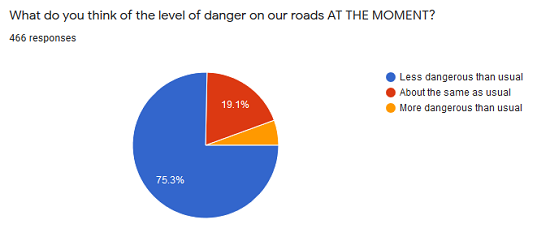
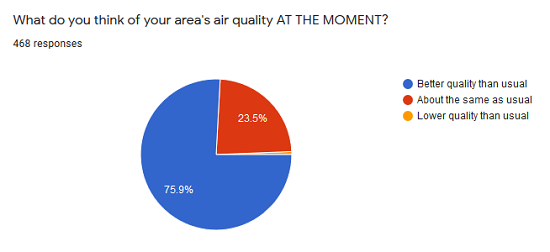
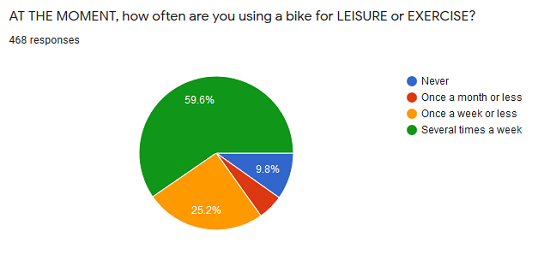
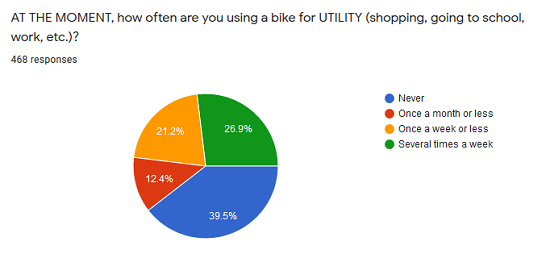
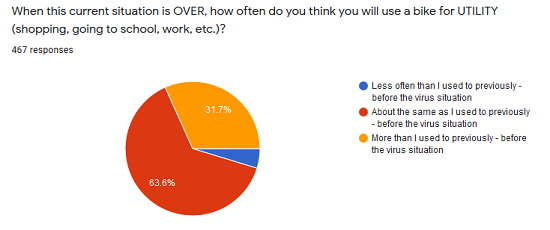
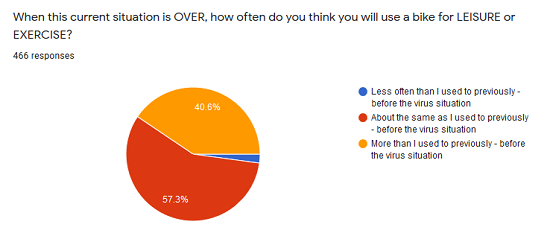

great information, when pandemic, cycling can help boos health and relax the mind